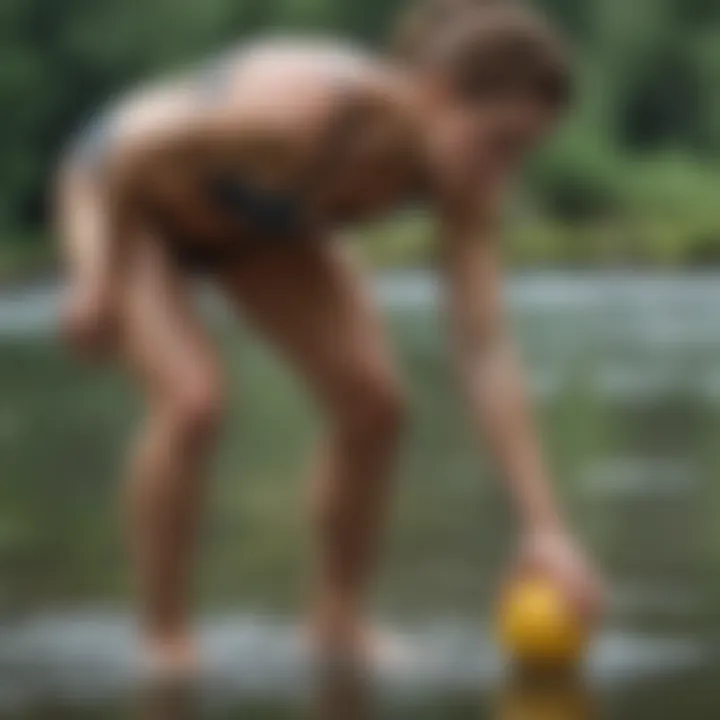Preventing Cramps in Watersports: Key Strategies


Intro
Cramps can be a major downer—especially for those who thrive on watersports. Picture it: you’re gliding through the waves, feeling like a pro, and then, out of nowhere, comes that dreaded tightness in your leg. They can throw a wrench in your day, making it not just uncomfortable, but also limiting your performance and enjoyment. With the right tools and strategies, these pesky intruders don’t have to ruin your time on the water.
In this article, we will dig into various techniques and insights to help you keep cramps at bay. This isn't just about toughing it out or crossing your fingers, but rather understanding how to prep your body—and your equipment—before hitting those waves. From hydration routines to specific dietary choices, we’ll cover all the bases. No matter if you are a novice looking to enjoy your first paddle or a seasoned surfer wanting to refine your skills, the information herein aims to enhance your on-water experience by minimizing discomfort. Let's get rolling and arm ourselves with knowledge that will keep cramps far away!
Understanding Cramps
Cramps can be more than just a passing annoyance; they can severely disrupt performance, especially for those engaged in watersports. Understanding cramps is crucial to keeping muscle control and ensuring enjoyable, uninterrupted activity on the water.
Cramps occur when muscles involuntarily contract and fail to relax, leading to a range of physical discomfort. This section delves into the specifics of cramps, their types, causes, and what can be done to mitigate their impact. By grasping the mechanics behind cramps, you can equip yourself with strategies to prevent them, allowing you to fully immerse in your watersport endeavors.
What Are Cramps?
Cramps represent a sudden and often painful muscle contraction. They can strike unexpectedly and may last a few seconds or longer. Understanding cramps involves recognizing how they occur. Generally, when a muscle's nerve is overactive or when it gets fatigued, it can pull tight without the usual relaxation phase. This leads to what many describe as a muscle knot that can cause immediate discomfort.
Types of Cramps
Cramps can come in various forms, each with unique characteristics and triggers. Below are the most common types of cramps that one might encounter:
Muscle Cramps
Muscle cramps are perhaps the most recognized type. Generally affecting the legs, arms, or abdomen, these cramps can stem from multiple factors including dehydration and over-exertion. The key feature of muscle cramps lies in their sudden onset; they often catch the athlete off guard. This unpredictability is a significant reason they are highlighted in discussions about preventing cramps. While not every muscle cramp signifies a serious problem, their occurrence can be a warning sign to pay closer attention to hydration and nutrition.
Heat Cramps
Heat cramps occur during intense exercise in hot environments. They are often more prevalent in athletes engaged in outdoor activities, like surfers or paddleboarders. The primary risk factor here is heat exhaustion coupled with fluid loss, leading the muscles to spasm. Therefore, a key characteristic of heat cramps is their direct relation to temperature and hydration levels. The unique feature of heat cramps is that they serve as a signal to the body, indicating that immediate cooling and rehydration are necessary. Ignoring these cramps can escalate to more severe heat-related illnesses.
Nighttime Leg Cramps
If you've ever been jolted awake with an intense cramp in your leg, you’ve experienced a nighttime leg cramp. These cramps often happen in the calf muscles and can be caused by prolonged sitting or lying in one position. The defining characteristic is their timing, usually striking when a person is at rest. While they can be a benign occurrence, frequently experiencing such cramps may warrant attention to one’s sleeping positions or daily activity levels. The unique aspect of nighttime leg cramps is that they can disrupt essential sleep patterns, making their management particularly important for overall well-being.
Causes of Cramps
Understanding the root causes of cramps helps pave the way for prevention. Here’s a closer look at the primary contributors:
Dehydration
Dehydration serves as a major precursor to cramps. A significant aspect of dehydration is that it thins the blood and leads to the loss of essential salts and minerals, which are vital for muscle function. When fluid levels drop, the muscle fibers and nerves can become more easily irritated, setting the stage for cramping incidents. Proper hydration before, during, and after activity is thus a critical component of reducing cramps. Ignoring hydration can often lead to cramps, turning refreshment into a necessity.
Electrolyte Imbalance
An imbalance of electrolytes, which include sodium, potassium, calcium, and magnesium, can also lead to muscle cramps. Each of these minerals plays a critical role in muscle contractions and nerve signaling. When levels dip too low, muscles may react by cramping, as they become unable to receive the correct signals from the nerves. Maintaining an adequate intake of these minerals is fundamental, especially for those who sweat heavily during activity.
Overexertion
Pushing the body beyond its limits is often a recipe for disaster. Overexertion frequently leads to fatigue and subsequent cramps. The risk here is plain: When the muscles get tired, they tend to cramp in response to continued exertion. Awareness of one’s limits and pacing oneself is a crucial strategy in reducing cramps from overworking.
Lack of Conditioning
A lack of proper physical conditioning can leave muscles unprepared to handle the demands of exercise. Individuals who dive into rigorous activity without gradual preparation are prone to cramps. Conditioning creates a baseline of strength and endurance; without it, muscles may thread the needle between optimal function and cramping more easily. Establishing a routine that allows gradual increases in intensity can greatly reduce the chance of cramps.
Hydration Strategies
Keeping the body adequately hydrated is one of the cornerstones of effective cramp prevention. When participating in watersports, especially under the blazing sun and in the shimmering waves, the importance of hydration can’t be overstated. Dehydrated muscles are more prone to cramps, which can cut short any enjoyable outing on the water. Not only does proper hydration support muscle function, but it also helps in regulating body temperature and maintaining energy levels.
Importance of Hydration
Hydration plays a vital role in optimizing performance during any physical activity. When you’re out there paddling or surfing, your muscles need a sufficient water supply to function properly. If dehydration sets in, it can lead to fatigue, reduced endurance, and, of course, cramps—something every water enthusiast wants to avoid. Staying hydrated also improves circulation, allowing oxygen and nutrients to flow to your muscles more efficiently. Think of hydration as the oil that keeps your performance engine running smoothly.
Signs of Dehydration
It’s essential to recognize when your body is running low on fluids. Some common signs of dehydration include:
- Thirst
- Dry mouth and throat
- Dark yellow urine
- Dizziness or light-headedness
- Fatigue
- Muscle cramps
When you notice these symptoms, it's like a red flag waving in the wind, signaling that it’s time to soak up some water before things get out of hand. Ignoring dehydration can lead you down a slippery slope towards unwanted cramps or worse.
Best Practices for Staying Hydrated


To keep cramps at bay, we need a game plan. Here’s how to ace your hydration strategy:
Pre-Activity Hydration
Before you hit the water, it’s crucial to start hydrating well in advance. About 2-3 hours prior to activity, it's wise to drink plenty of fluids, ideally water or electrolyte drinks. This helps to prime your body and ensures that your fluid levels are at their peak when you start. One unique feature of pre-activity hydration is that it can enhance your performance by ensuring that your muscles are flexible and ready for action, which reduces the likelihood of cramps kicking in. However, be careful not to overdo it, as excess fluid can lead to discomfort.
During Activity Hydration
Once you’re in the thick of things, hydration needs to remain a priority. Sipping water or an electrolyte solution every 15-20 minutes can do wonders. The key characteristic of during activity hydration is its ability to quickly replenish fluids lost through sweat. Using this technique means your body doesn’t have to play catch-up, making it less likely for cramps to rear their ugly heads. Just remember, if you wait until you're thirsty, it’s often too late.
Post-Activity Hydration
Don't forget to hydrate after your session too. Replenishing fluids lost during your time in the water is equally essential. Aim to drink a mix of water and electrolytes post-activity to effectively restore your body's balance. This kind of hydration is vital for recovery. A unique advantage of post-activity hydration is that it helps your muscles recover faster, making it less likely for cramps to happen during your next outing.
"Hydration is not just about drinking water; it’s about maintaining balance within your body, enabling you to perform at your best."
By weaving these hydration practices into your routine, you can significantly minimize the risk of cramps and keep those fun-filled adventures on the water rolling smoothly.
Dietary Considerations
Dietary considerations are central to preventing cramps, especially for individuals engaged in watersports. Proper nutrition equips the body with essential nutrients that support muscle function, help maintain hydration, and ultimately fend off those unwanted cramps. Ignoring these dietary aspects could lead to subpar performance and discomfort, turning what should be an enjoyable day on the water into a frustrating experience. It's crucial to find the right balance of nutrients to ensure muscles are primed for action, adequately fueled, and ready to endure the demands of aquatic activities.
Key Nutrients for Muscle Function
Potassium
Potassium plays a pivotal role in muscle contraction and nerve signaling. It's crucial for maintaining proper fluid balance, which is essential for optimal muscle function. With this mineral, the muscles receive the signal to contract properly, thus limiting the chances of involuntary cramps. A standout feature is its high concentration in bananas, which are often hailed as an athlete’s best friend.
While beneficial, it's vital to consume potassium within a balanced diet, as too much can lead to irregular heartbeats and other complications.
Sodium
Sodium often gets a bad rap when it comes to health, but it is equally important in preventing cramps. It assists in retaining fluids and helps maintain blood pressure. During intense physical activities, particularly in hot environments, sodium loss through sweat can lead to cramping if not replaced. An interesting aspect is sodium's role in helping muscles fire quickly during high-intensity workouts, making it a favorite among competitive athletes. However, moderation is key; excessive sodium can lead to other health issues, especially if hydration levels aren't adequately maintained.
Magnesium
Magnesium is a crucial player in muscle relaxation and recovery. It helps to prevent muscle stiffness, reducing the likelihood of cramps during and after performance. Foods rich in magnesium, like spinach and almonds, are often overlooked but can provide significant benefits. One unique feature of magnesium is its dual role; it not only supports muscle function but also aids in energy production, making it a favorite among endurance athletes. Too little magnesium can contribute to cramps, thus highlighting its importance in regular dietary intake.
Calcium
Calcium is well-known for its role in bone health, but it's just as critical for muscles. It is necessary for muscle contraction, meaning a deficiency can directly lead to cramping. Foods rich in calcium, like dairy products and leafy greens, are excellent choices to maintain muscle health. A unique aspect to note is that calcium must be balanced with magnesium for optimal absorption and function. Neglecting this balance might lead to issues, including cramping and muscle fatigue.
Foods to Include in Your Diet
Fruits and Vegetables
Incorporating fruits and vegetables into the diet is crucial for cramp prevention. Rich in vitamins, minerals, and antioxidants, they support overall muscle function and hydration. For example, watermelon has a high water content and potassium, making it an excellent choice for hydration. The unique feature of fruits and vegetables is their ability to provide nutrients in a low-calorie package, helping maintain energy levels during watersports. While they are beneficial, it’s important to consume a variety to cover all nutrient bases.
Nuts and Seeds
Nuts and seeds are powerhouses of nutrition. They are packed with essential fatty acids, protein, and key minerals, particularly magnesium and potassium. For example, almonds are a great source of magnesium, which is beneficial post-activity to aid recovery. One special trait of nuts is their convenience; they're easy to bring along during excursions. However, moderation is essential, as their high-calorie content can lead to unintended weight gain if consumed excessively.
Dairy Products
Dairy products offer a rich source of calcium and protein. Including low-fat yogurt or cheese in your diet can not only help with muscle recovery but also contribute to overall wellness. The unique aspect of dairy is its versatility – suitable for snacks or meals, making it easy to incorporate into a busy lifestyle. Some individuals may struggle with lactose, which can limit options, but lactose-free alternatives still provide the same benefits.
Whole Grains
Whole grains are another essential food group that should not be overlooked. They provide a steady source of energy, which is crucial for sustaining performance during extended activities. For example, brown rice and oats are high in fiber and offer critical vitamins like B6, which is important for energy metabolism. A notable feature of whole grains is their ability to keep you feeling full longer, helping to avoid energy dips that could lead to cramps. As with other foods, ensuring portion control is necessary to manage energy output effectively.
Avoiding Cramps through Nutrition
Preventing cramps via nutrition is not just about what you eat immediately before you hit the water. It's a holistic approach that involves adequate planning and thoughtful choices about your overall diet. Consistently consuming these nutrients and foods will help ensure your body is well-equipped to handle the strain of watersports, helping you remain both comfortable and powerful on the waves.
"The right fuel is just as important as the right technique. Nourish your body well, and it will reward you in performance."
Stretching Techniques
Stretching techniques play a pivotal role in preventing cramps, particularly for those engaged in watersports. When muscles are stretched properly, they become more flexible, which can help prevent the tightening or spasming that leads to cramps. This is not merely about achieving a fancy split; it's about enhancing muscle performance and promoting blood flow, both crucial steps before and after physical activities in the water. Stretching establishes a routine that primes the muscles and prepares the body for rigorous exertion. Moreover, consistent stretching can reduce the risk of injury, making it an essential element of a warm-up and cool-down regimen.
Importance of Stretching


The importance of stretching cannot be overstated. It serves as a warm-up to engage muscles, ease tension, and improve overall flexibility. Users of watersports require a good range of motion to maneuver effectively, and stretching can assist with that. By making it a regular practice, athletes may observe a notable increase in their endurance levels.
Additionally, stretching contributes to muscle recovery, enhancing performance while reducing soreness post-activity. If you’re looking to ride the waves and not be struck by a cramp halfway through, stretching should be a non-negotiable part of your strategy.
Effective Stretching Routines
Dynamic Stretching Before Activity
Dynamic stretching involves engaging the muscles through a controlled motion rather than holding a position. Think of it like getting the engines revved up before taking off. This approach fuels blood flow and enhances muscle readiness, making it an effective measure to prevent cramps.
Before any watersport activity, consider incorporating movements such as leg swings, arm circles, and torso twists. Each of these stretches targets multiple muscle groups, preparing them for what’s to come. Dynamic stretching is especially popular because it mimics the movements of your chosen sport, allowing your body to adapt seamlessly to the demands that will follow.
However, it's important to avoid overstretching during these routines as that can lead to other forms of strain. Generally, dynamic stretching is considered a beneficial choice for pre-activity preparation.
Static Stretching Post Activity
In contrast, static stretching is about holding a position for a period of time, typically ranging from 15 to 60 seconds. After an intense activity on the water, static stretches are essential for muscle recovery. This method allows the muscles to relax and elongate, improving flexibility, and can also help in dissipating the aftermath of any strain or tension incurred during performance.
Popular static stretches include the cross-body shoulder stretch, hamstring stretch, and calf stretch. The unique feature of static stretching lies in its ability to foster relaxation and enhance muscle elasticity. Although it provides significant advantages in terms of recovery and preventing cramps, practitioners should be mindful to stretch gently to avoid overstretching.
Targeting Common Muscle Groups
Calves
Calf stretches are crucial because cramped calves can hinder swimming or paddling activities significantly. The primary characteristic of calf muscles is their constant engagement during any aquatic activity, which makes them prone to fatigue. Incorporating exercises like the standing calf stretch can keep them limber and responsive. Often, tight calves can be the tipping point for cramping, so prioritizing them in your routine can be beneficial.
Hamstrings
Hamstring stretches are equally important, seeing as these muscles play a vital role in leg movement and power generation. A common practice is to do standing or seated hamstring stretches. The flexibility gained from regular hamstring stretching contributes directly to improving performance by allowing a full range of movement.
However, one should be cautious as over-stretching can lead to tears, so maintaining a balance is key.
Quadriceps
Quadriceps stretches address the front of the thighs, where cramping can occur, especially after repetitive leg motion. A standing quad stretch can be a simple yet effective way to engage this muscle group. Because these muscles are heavily used when exerting force, keeping them flexible and well-conditioned is crucial for anyone involved in any type of watersport.
Lower Back
Lastly, stretching the lower back is vital. A tight lower back can lead to discomfort during activities on the water. Incorporating stretches like the child’s pose or lumbar twists can alleviate tension, enhance flexibility, and ultimately help maintain a fluid range of motion. Given the demands on the body during watersport activities, keeping the lower back engaged and stretched can prevent serious issues down the line.
Remember, incorporating a good blend of both dynamic and static stretching significantly reduces the likelihood of cramping while engaging in watersports. Whether it's surfing or paddleboarding, a few well-placed stretches could be the difference between having a blast and battling cramps.
Warm-Up and Cool Down
Preparation is key when diving into watersports, and this is where warm-ups and cool-downs come into play. Applying these practices assists in minimizing the risk of cramps, enhancing performance, and overall enjoyment of water activities. Consider warm-ups as your pre-game ritual, setting the stage for what’s to come, while cool-downs, on the other hand, help to ease your muscles back into a relaxed state after an intense session. In this section, we’ll explore their significance in cramp prevention along with practical exercises that can be easily integrated into your routine.
The Role of Warm-Ups
Warm-ups are not just about getting the blood circulating; they prime your muscles and mental state for exertion. Engaging in a proper warm-up increases core temperature, making muscles more pliable and maximizing their effectiveness. This flexibility is crucial in avoiding those sudden, painful muscle contractions known as cramps.
Warm-ups also prepare your cardiovascular system for physical activity. Undoubtedly, it’s not uncommon for surfers to face unpredictable waves, and a body ready to roll with the punches can significantly reduce the chance of cramping up mid-ride.
Sample Warm-Up Exercises
Integrating warm-up exercises into your routine can make a world of difference. Here are a few practical movements to consider before hitting the water:
- Arm Circles: Stand with arms extended and make circular motions. This loosens shoulders and enhances shoulder mobility.
- Leg Swings: While holding onto a stable object, swing one leg forward and backward. It promotes hip flexibility, essential when maneuvering on your board.
- Torso Twists: With feet planted, gently twist your torso left and right. This mobilizes your lower back, ensuring all parts are ready for action.
Each warm-up should last about 5-10 minutes, allowing enough time for your body to adjust.
Benefits of Cooling Down
Let’s now talk about the cool-down. Many might overlook this step, but it’s just as important as the warm-up. Gradually lowering your heart rate can prevent problems like dizziness and muscle soreness after activities. Cooling down aids in flushing out lactic acid, which can build up during intense activity and lead to cramps.
Incorporating cool-down exercises, much like warm-ups, can promote flexibility. Simple stretches can be the ticket to easing tight muscles and preventing soreness later. A good guideline is to spend 5-10 minutes performing gentle stretches post-activity, focusing on the areas that worked the hardest during your sport.
As a sturdy takeaway, when it comes to cramp prevention in watersports, don’t underestimate the power of both warm-ups and cool-downs. They’re essentially bookends to your activity that can make or break your experience. Stay smart, prepare wisely, and you’ll navigate those waters with ease.
Managing Overexertion


Overexertion can strike when least expected, particularly during those thrilling watersports adventures. Not only can it lead to fatigue and, more concerning, cramps, but it can also derail your performance and enjoyment on the water. Hence, grasping the nuances of managing overexertion is critical for anyone looking to refine their athletic prowess.
Recognizing when you're pushing too hard requires a deep understanding of your body. Everyone has their limits, but for many, those limits can tend to creep further out as they build strength and endurance. This phenomenon, while encouraging, can also put one at risk for unwanted muscle cramps.
Recognizing Limits
Understanding your physical boundaries is not just good practice; it's a necessity. When engaging in intense activity, it’s easy to get sucked into the adrenaline and push through when you shouldn't. Common signs that you may be overexerting include excessive fatigue, shortness of breath, and even nausea. If you find yourself thinking, "I can keep going, I just need to push a little further," take a step back. Your body may be sending warning signals that you need to heed. Familiarizing yourself with these cues will keep you from treading into dangerous waters—both literally and figuratively.
Some practical tips to help recognize your limits include:
- Listen to your body: If it feels like you are on the verge of hitting a wall, take a moment to assess how you're feeling. Consider taking breaks or easing up on the intensity.
- Monitor performance: Keep a journal of your training sessions to note how you felt during and after activities. Patterns will emerge, helping you recognize when you're pushing too far.
- Share with peers: Fellow surfers or paddleboarders can often notice when someone is struggling before they do. Don't hesitate to ask for feedback!
Gradual Conditioning Plans
In the quest to conquer your favorite watersport, a gradual conditioning plan can serve as a roadmap to success. Such a plan is not merely about putting in the hours; it’s about strategically increasing intensity, duration, and frequency over time.
Think of it like planting a seed and nurturing it. You wouldn’t dump a whole bucket of water on the seed and expect it to sprout overnight; likewise, your body needs time to adapt to increasing demands. Here’s how to create a sound conditioning plan:
- Set realistic goals: Determine what you want to achieve, whether it's a longer surf session or improved endurance.
- Incremental increases: Instead of jumping headfirst into marathon training or trying to paddle your hardest from the first day, increase your activity level slowly, aiming for about a 10% increase each week.
- Cross-training: Incorporate other forms of workouts that can enhance your performance, such as yoga to improve flexibility or resistance training to build strength.
- Rest and recovery: Make sure to build in rest days to allow your muscles to recuperate. Neglect can lead to setbacks and increase the likelihood of cramps.
By diligently applying these practices, you safeguard against overexertion and give yourself a solid foundation for those exhilarating water-filled exploits ahead. As you navigate these waters, keep the emphasis on consistency and gradual improvement.
Managing overexertion is not just a physical matter. It requires a mindset that respects your body's signals and honors its need for rest. Doing so establishes a sustainable approach to any water activity.
By mastering these elements of managing overexertion, you’ll safeguard your body against the discomfort and surprises cramps can bring, making every experience on the water as enjoyable as possible.
Utilizing Recovery Techniques
When it comes to preventing cramps, recovery techniques can play a huge role. Many watersports enthusiasts often overlook this phase, thinking it's just about hydration and diet. However, recovery isn't merely a box to check. It serves as an essential part of your performance and overall muscle health. Declining to implement adequate recovery methods can set you up for a nasty cramp episode when you least expect it—like during a wave or a hard paddle.
Benefits of Recovery Techniques:
- Muscle Repair: Intense physical activity takes a toll on muscles. Recovery allows for muscle fibers to mend, making them stronger.
- Injury Prevention: Without proper recovery, overworked muscles are prone to injuries, which can lead to time off the water.
- Enhanced Performance: As muscles recover, they can operate at full capacity, improving your agility and stamina during sports.
Utilizing recovery techniques also includes preparing yourself for the next session. Knowing how to bounce back not only makes you feel good, it gets you ready for sport again, reducing the risk of future cramps.
Post-Activity Recovery
Post-activity recovery has paramount importance, particularly following rigorous watersports sessions. Your body is not just a machine; it needs time to repair itself after being put through the wringer. Here, we’ll go over a few key strategies for effective post-activity recovery:
- Rehydration: After engaging in any water sports, make sure to drink water or a sports drink. This helps replace fluids lost through sweating, preventing those muscles from tightening up.
- Gentle Stretching: While it might be tempting to sprawl on the couch, some light stretching can alleviate tension and promote blood flow to the muscles.
- Nutritional Refueling: Eating a balanced meal infused with protein and carbs within 30 minutes of finishing your activity can speed up recovery. Think grilled chicken with quinoa and veggies.
- Foam Rolling: This technique can assist in releasing muscle tightness and improve blood circulation. A rolling pin for your muscles, if you will!
- Tip: Try coconut water, which contains natural electrolytes that are great for hydration.
By implementing these post-activity recovery techniques, you can significantly mitigate the chances of cramping in your next outing.
Importance of Sleep in Recovery
Sleep is often underestimated when discussing recovery, but it is the bedrock of muscle and overall physical health. After a long day of paddleboarding or kitesurfing, you might feel tired, but skipping out on a good night’s sleep could be detrimental to your recovery process.
- Muscle Growth: During sleep, growth hormone levels peak, which contributes to muscle growth and repair. Not enough sleep means less muscle recovery, paving the way for cramps.
- Cognitive Function: A well-rested mind is crucial for focus and coordination on the water. Feeling dazed and confused will not help your performance.
- Immunity Boost: Poor sleep can lead to a weaker immune system, increasing your risk for illness, which can further limit your time spent enjoying your favorite activities.
As a rule of thumb, aim for 7 to 9 hours of sleep per night to allow your body to heal and recover effectively.
"Sleep is the best meditation." — Dalai Lama
In summary, utilizing recovery techniques post-activity and prioritizing sleep can make a world of difference in your muscle health and performance. By allowing your muscles to recover properly, you not only reduce the risk of cramps but also set yourself up for success in your future watersport sessions.
When to Seek Professional Help
It's critical to recognize when cramps escalate beyond the ordinary discomfort we often ignore. Ignoring persistent cramps can lead to serious complications and hamper overall performance in water sports. This section aims to provide clarity on specific indicators that require professional intervention, how to identify them, and the benefits of seeking timely medical advice.
Identifying Severe Cases
Cramps can range from standard muscle tightness to debilitating spasms that disrupt activities. Here are several signs pointing towards a severe case:
- Prolonged Duration: If cramps last more than a few minutes and don’t improve with self-care measures, it's a signal to act.
- Intense Pain: Severe discomfort that feels different from typical aches, particularly in the lower legs or abdomen, might warrant further investigation.
- Swelling or Redness: Any swelling, discoloration, or abnormal changes in skin appearance could indicate deeper issues, such as a blood clot.
- Inability to Move a Muscle: If it's hard to move the affected area after the spasm, this could suggest an underlying problem needing attention.
- Recurrent Episodes: Frequent episodes of cramps, especially if they disrupt performance consistently, should not be brushed aside.
Cramps may seem like a minor inconvenience, but recognizing the signs of serious issues is key. Pay attention to your body; it often signals when something isn’t right.
Consulting Healthcare Professionals
Now that we've set the groundwork for identifying serious cramping episodes, the next step is understanding how to navigate consulting healthcare professionals. Here are some essential points you should consider:
- Primary Care Physician: Start by discussing your symptoms with your regular doctor. They can perform a basic evaluation to check for any underlying health issues affecting muscle function.
- Sports Medicine Specialist: If your cramps are consistent with performance hindrances, consulting a sports medicine expert can be beneficial. They specialize in activity-related injuries and can provide tailored advice on prevention and recovery strategies.
- Physical Therapist: Engaging with a physical therapist can be a game-changer. They can offer specific exercises to stretch and strengthen vulnerable muscle groups, thus minimizing cramps' likelihood.
- Nutritionist: Dietary advice is invaluable, especially when cramps arise from nutrient deficiencies. A nutrition expert can help optimize your dietary intake, ensuring you're fueling your body adequately for water activities.
- Urgent Care or ER: In extreme situations where cramps are accompanied by severe symptoms like chest pain or difficulty breathing, visit an urgent care center or emergency room immediately.
By seeking professional guidance when necessary, you’re reinforcing your commitment to both health and performance. In water sports, where agility and endurance are key, addressing cramps early can keep you on your board, in the water, and away from the sidelines.



